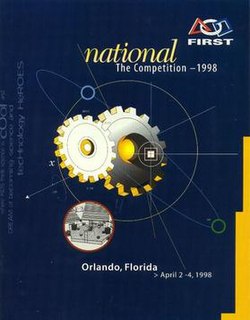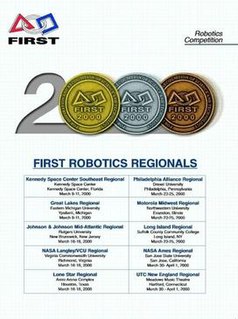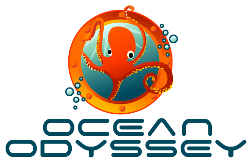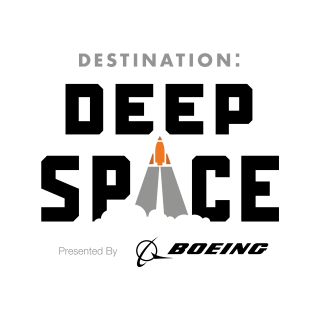
BattleBots is an American robot combat television series. The show was an adaptation of the British show Robot Wars, in which competitors design and operate remote-controlled armed and armored machines designed to fight in an arena combat elimination tournament. For five seasons, BattleBots aired on the American Comedy Central and was hosted by Bil Dwyer, Sean Salisbury, and Tim Green. Comedy Central's first season premiered on August 23, 2000, and its fifth and last season ended on December 21, 2002. The show was in hiatus until it was revived on ABC in 2015.

Aim High was the 2006 game for the FIRST Robotics Competition. The competition involved teams competing to gain points by delivering balls into goals and positioning their robots in certain positions on the playing field. The teams took it in turn to provide defense and attack.

Ladder Logic was the game for the 1998 FIRST Robotics Competition.

Co-Opertition FIRST was the 2000 game for the FIRST Robotics Competition.

In the 2007-2008 FIRST Tech Challenge robot competition, Quad Quandary is the first challenge theme replacing the former FIRST Vex Challenge, with similar general rules regarding the specifications of the robot and the game play. Unlike the previous challenge, Hangin'-A-Round, Quad Quandary makes use of small rings and movable goal posts.

Half-Pipe Hustle was the first official FIRST Vex Challenge (FVC) game, taking place in 2005–2006. In this challenge, robotics teams built robots from the Vex design kit to compete in competitions across the United States and in other nations, in matches consisting of a 45-second autonomous period, followed by a 2-minute driver control period in which the robots are controlled by team drivers using remote controls.

Lunacy is the game for the 2009 FIRST Robotics Competition. Announced on January 3, 2009, the name and some of the features of the game honor the 40th anniversary of the first human mission to the Moon. It is FRC's 18th game. This is the first FRC competition to use the cRIO Mobile Device Controller control system from National Instruments. The driver station introduced for 2009 was the Kwikbyte DS, which was replaced in 2010 by the Classmate PC.
Breakaway is the game for the 2010 FIRST Robotics Competition, announced on January 9, 2010. Robots direct soccer balls into goals, traverse "bumps" in the field, suspend themselves and each other on towers, and/or go through a tunnel located in the center of the field.
Get Over It! is the robotics competition event for the 2010-11 FIRST Tech Challenge. Two teams compete to score points by depositing colored batons in various types of goals. The name of the game refers to the many obstacles that traverse the middle of the field, which include a mountain, two bridges, and two ramps.

Logo Motion is the 2011 FIRST Robotics Competition game. Playing pieces are inner tubes shaped like the components of the FIRST logo. The primary objective of the game is to place them on racks to gain points. In the endgame, robots deploy smaller robots ("minibots") to climb a tower. Minibots must be made from the FIRST Tech Challenge kit of parts. The game celebrates the 20th season of the FRC and is also meant to commemorate the artist Jack Kamen, who designed the original FIRST logo.

Ocean Odyssey is the 2005-06 FIRST Lego League challenge theme. It centered on topics relating to the world's oceans and oceanography. The challenge was developed with the collaboration of the Woods Hole Oceanographic Institution and the Monterey Bay Aquarium Research Institute.

No Limits is the 2004-05 FIRST Lego League challenge theme. It focused on solutions for aiding people with physical disabilities. The year's theme was introduced by the story Late for Lunch by James Patrick Kelly, which the described the life of a disabled child.

Ultimate Ascent was the 2013 FIRST Robotics Competition game. It is styled similarly to disc golf.

Aerial Assist was the 2014 FIRST Robotics Competition game.

Recycle Rush was the 2015 FIRST Robotics Competition game. It involves picking up and stacking totes on scoring platforms, putting pool noodles ("litter") inside recycling containers, and putting the containers on top of scoring stacks of totes. There is also a coopertition aspect of the game where both alliances of teams can pool their totes and stack them on a step dividing the field to each gain twenty points. Along with these robot actions, human players can attempt to throw the pool noodles across the field to gain four points for each noodle left in the opposing alliance's work zone.
FIRST Stronghold was the 2016 FIRST Robotics Competition game. The game was played by two alliances of up to three teams each, and involves breaching the opponents’ defenses, known as outer work as well as capturing their tower by first firing "boulders" at it, and then surrounding or scaling the tower using a singular rung on the tower wall. Points were scored by crossing elements of the tower's outer works, shooting boulders into the opposing tower's five goals in order to lower the tower strength, and by surrounding and scaling the tower.
VEX Robotics is a robotics program for elementary through university students, and a subset of Innovation First International. The VEX Robotics competitions and programs are managed by the Robotics Education and Competition Foundation (REC). In April 2018, VEX Robotics Competition was named the largest robotics competition in the world by Guinness World Records.

Destination: Deep Space, stylized as DESTINATION: DEEP SPACE and officially known as Destination: Deep Space Presented By The Boeing Company, is the FIRST Robotics Competition game for the 2019 season. It involves two alliances of three teams each, with each team controlling a robot and performing specific tasks on a field to score points. The game centers around an outer space theme involving two alliances consisting of three teams each competing to place poly-carbonate hatch panels and orange rubber balls or "cargo" on rockets and cargo ships before returning to their HAB platform to climb at the end of the match.

Rover Ruckus, officially known as Rover Ruckus Presented by Qualcomm for sponsorship reasons, is the FIRST Tech Challenge game for the 2018–2019 season. In the competition, two alliances of two teams each compete to collect minerals and place them into the cargo holes of the lander. Rover Ruckus is the fourteenth FTC game.

Rapid React, stylized as RAPID REACT and officially known as Rapid React presented by The Boeing Company for sponsorship reasons, is the FIRST Robotics Competition (FRC) game for the 2022 season. The game is themed around transportation as part of the FIRST-wide FIRST Forward theme for 2021-2022.















